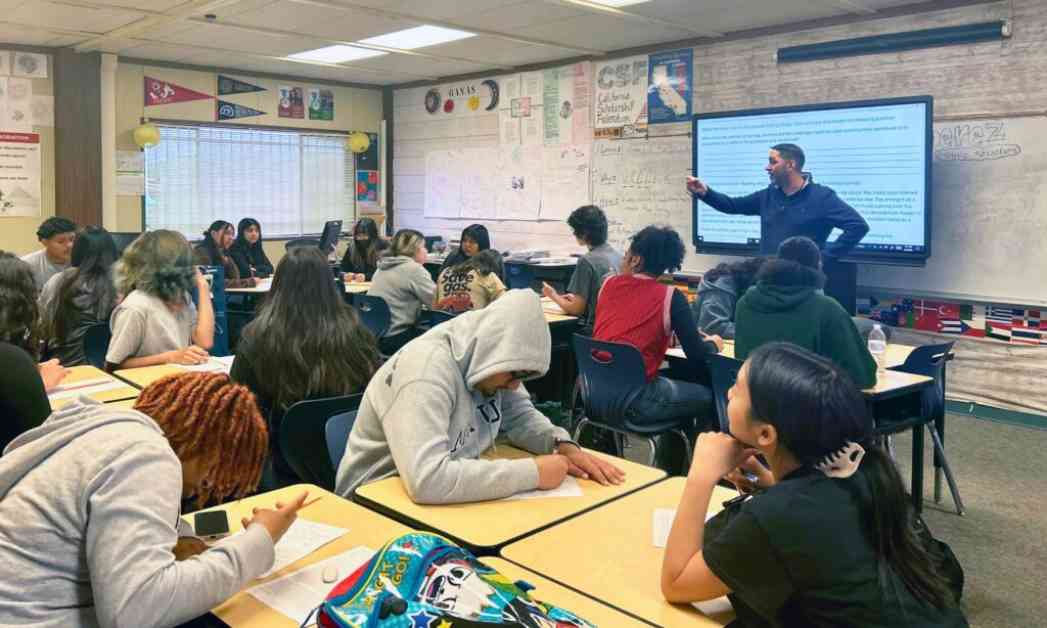In the bustling hallways of Duncan High School, students gathered in Gabriel Perez’s ethnic studies class, delving into the origins of hip hop and rap music, woven with the lived experiences of young African American artists. These narratives often painted a vivid picture of social issues like poverty, gang violence, and racism that shaped their communities.
The spark that ignited this passion for untold stories began in October 2017 when Fresno Unified teacher Lauren Beal proposed an ethnic studies class at Edison High. Recognizing the need for students to learn the historical truth about Black Americans, Beal’s vision was welcomed by the school, serving a higher percentage of Black students compared to the district, county, or state. This initiative was soon complemented by the adoption of an ethnic studies class focusing on Latino Americans at the same school.
This grassroots movement soon rippled across the state, with teachers in various schools advocating for these inclusive courses. By 2020, a collective vision emerged among ethnic studies educators in Fresno Unified – envisioning thousands of students, beyond just a few hundred, having the opportunity to explore the untold stories of diverse communities. The Fresno Ethnic Studies Coalition was born out of this aspiration, aiming to establish and implement the course district-wide while amplifying the district’s investment.
The culmination of these efforts led to a pivotal moment in August 2020 when the Fresno Unified school board passed a resolution, declaring ethnic studies a graduation requirement. This mandate, way ahead of the state’s 2025-26 deadline for an ethnic studies course, positioned Fresno Unified students to embark on a transformative journey through a two-semester course essential for graduation.
Despite the initial enthusiasm that birthed the creation of these courses and the graduation requirement, a cloud of uncertainty looms over the development of the program, leaving some teachers questioning the roadblock and its potential ties to dissent elsewhere in the state. Lauren Beal, now teaching AP African American studies, reflected on the journey, acknowledging the progress made in a short span of time.
District leaders hailed the bold move to mandate an ethnic studies course, recognizing that only a few California school systems had ventured down this path. While some districts opted for a gradual implementation, Fresno Unified’s leap highlighted a commitment to embracing the diverse narratives embedded within ethnic studies.
As the curriculum expanded to encompass comprehensive ethnic studies, Chicano studies, African American studies, Asian American studies, women and gender in ethnic studies, and AP offerings, Fresno Unified took proactive steps to equip teachers with the necessary tools. Professional development in ethnic studies was offered, enabling educators to interact with peers across the state and obtain graduate certifications in the subject.
Despite these strides, accusations of ambivalence within the district’s decision-making processes have stalled the program’s progress, triggering concerns among educators like Marisa Rodriguez. This perceived lack of clear rationale and accountability has left teachers grappling with the absence of a cohesive support system.
The heart of ethnic studies in Fresno Unified beats through the efforts of dedicated educators, shaping the minds of students across nine high schools and ten middle schools. The courses, some offered under dual enrollment, have not only met the A-G graduation requirements but also opened pathways to higher education through the University of California and California State University systems.
However, the success of ethnic studies implementation hinges on the district’s ability to recruit, train, and continually support its teachers. The challenge lies in bridging the gap for educators without a background in ethnic studies, like Heather Miller at Edison High, who grapples with shaping a curriculum that resonates with high school students while aligning with college-level content. The hunger for robust training and meaningful support echoes among teachers, underscoring the need for expert guidance in the ethnic studies discipline.
As the narrative unfolds, the story of Fresno Unified’s ethnic studies program takes an unexpected turn. A contract with Community Responsive Education, aimed at providing ongoing professional development and curriculum alignment, was abruptly terminated, leaving teachers and students in limbo. The absence of a clear explanation for this decision has stirred speculation and apprehension among educators, casting a shadow over the future of the program.
In the face of uncertainty, Fresno Unified’s ethnic studies teachers grapple with the implications of this abrupt halt. The fear of teaching materials coming under scrutiny, coupled with the absence of a protective mechanism for curriculum development, raises concerns about the sustainability of ethnic studies courses. The autonomy afforded to teachers is overshadowed by a culture of apprehension, impacting the recruitment and retention of educators passionate about ethnic studies.
In this delicate balance between autonomy and scrutiny, Fresno Unified navigates the complexities of ethnic studies implementation. The need for clarity, support, and protection looms large as educators strive to infuse counter-narratives and untold stories into the curriculum. As the district grapples with these challenges, the onus lies on fostering a culture of trust, transparency, and continuous learning to propel ethnic studies forward.
With the fate of the Community Responsive Education contract hanging in the balance, the future of Fresno Unified’s ethnic studies program teeters on the edge, awaiting a resolution that could shape the narrative of inclusivity and diversity in the district. As educators and district leaders grapple with these uncertainties, the essence of ethnic studies – centered around voices, ancestors, liberation, love, empathy, and yearning – remains at the core of the journey, guiding students through the rich tapestry of diverse narratives.
